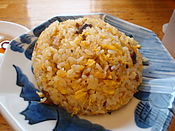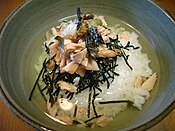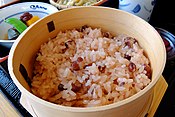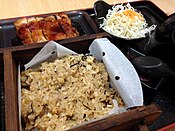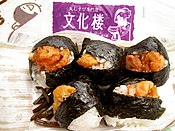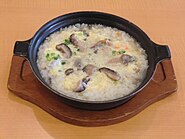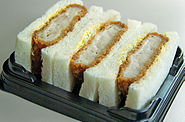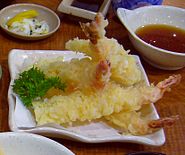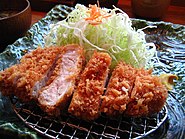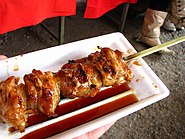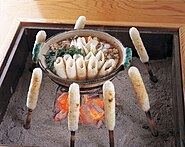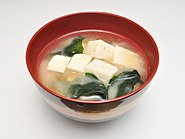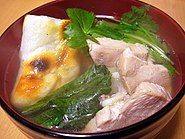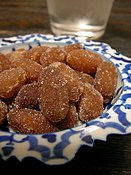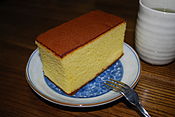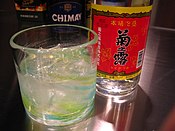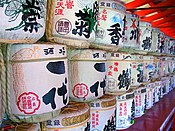List of Japanese dishes
This articleneeds additional citations forverification.(December 2012) |
 |
| This article is part of the series |
| Japanese cuisine Nhật Bản liệu lý |
|---|
|
|


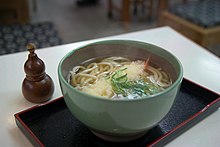
Below is alist of dishes found in Japanese cuisine.Apart from rice, staples inJapanese cuisineinclude noodles, such as soba and udon. Japan has many simmered dishes such as fish products in broth calledoden,orbeefinsukiyakiandnikujaga.Foreign food, in particularChinese foodin the form of noodles in soup calledramenand frieddumplings,gyoza,and other food such ascurryandhamburger steaksare commonly found in Japan.Historically, the Japanese shunned meat,but with the modernization of Japan in the 1860s, meat-based dishes such astonkatsubecame more common.
Rice dishes (ご cơm vật)
[edit]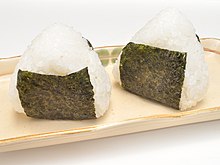
- Gohanormeshi:plainly cookedwhite rice.It is such a staple that the termsgohanandmeshiare also used to refer to meals in general, such asAsa gohan/meshi(Triều ngự cơm, triều cơm,breakfast),Hiru gohan/meshi(Ngày ngự cơm, ngày cơm,lunch), andBan gohan/meshi(Vãn ngự cơm, vãn cơm,dinner). Also, raw rice is calledkome(Mễ,rice), whilecooked riceisgohan(ご cơm,[cooked] rice).Nori(Rong biển), andfurikake(ふりかけ) are popular condiments in Japanese breakfast. Some alternatives are:
- Curry rice(karē raisuカレーライス): Introduced from the UK in the late 19th century, "curry rice" is now one of the most popular dishes in Japan. It is much milder than its Indian counterpart.
- Chāhan(Cơm chiên) or yakimeshi ( thiêu cơm ):fried rice,adapted to Japanese tastes, tends to be lighter in flavor and style than the Chinese version from which it is derived
- Genmai gohan(Huyền mễ ngự cơm):brown rice
- Hayashi rice(ハヤシライス):thick beef stew on rice
- Kamameshi(Phủ cơm): rice topped with vegetables and chicken or seafood, then baked in an individual-sized pot
- Katemeshi:apeasant foodconsisting of rice, barley, millet and chopped daikon radish[1]
- Mochi(Bánh): glutinous rice cake
- Mugi gohan/Mugi meshi(Mạch ngự cơm, mạch cơm): white rice cooked withbarley
- Ochazuke(Ngự vệt trà け): hotgreen teaordashi(Ra nước) poured over cooked white rice, often with various savory ingredients such asumeboshi(Mai làm) ortsukemono(Tí vật).
- Okowa(おこわ): cookedglutinous rice
- Omurice(Omu-raisu,オムライス): omelet filled with fried rice, apparently originating fromTōkyō
- Onigiri(おにぎり): balls of rice with a filling in the middle. Japanese equivalent of sandwiches.
- Sekihan(Xích cơm): white rice cooked withazuki beans[2](Đậu đỏ) toglutinous rice.(literallyred rice)
- Takikomi gohan(Xuy き込み ngự cơm): Japanese-stylepilafcooked with various ingredients and flavored with soy,dashi,etc.
- Tamago kake gohan(Trứng quải け ngự cơm): Rice with a raw egg
- Tenmusu:a rice ball wrapped with nori that is filled with deep-fried tempura shrimp[3]
Rice porridge (お cháo)
[edit]- Nanakusa-gayu(Bảy thảo cháo) is the long-standing Japanese custom of eating seven-herb rice porridge (nanakusa-gayu) on January 7 (Jinjitsu).
- Okayu(お cháo) is a ricecongee(porridge), sometimesegg droppedand usually served to infants and sick people.
- Zosui(Zōsui,Tạp xuy) orOjiya(おじや) is a soup containing rice stewed in stock, often with egg, meat, seafood, vegetables or mushroom, and flavored with miso or soy. Known asjuushiiin Okinawa. Some similarity torisottoand Kayu though Zosui uses cooked rice, as the difference is that kayu is made from raw rice.
Rice bowls (どんぶり)
[edit]A one-bowl dish, consisting of adonburi(どんぶり, tỉnh,big bowl) full of hotsteamed ricewith various savory toppings:
- Gyūdon:(Gyudon,beef bowl): Donburi topped with seasoned beef and onion
- Katsudon(カツ tỉnh): Donburi topped with deep-fried breaded cutlet of pork (tonkatsudon),chicken(chickendon)
- Oyakodon(Thân tử tỉnh): Donburi topped with chicken and egg (or sometimes salmon and salmon roe) (literallyParent and Childbowl)
- Tekkadon(Thiết hỏa tỉnh): Donburi topped with tunasashimi
- Tendon:(Thiên tỉnh): Donburi topped withtempura(battered shrimp and vegetables)
- Unadon:(うな tỉnh, man tỉnh): Donburi topped with broiled eel with vegetables
- Wappameshi:(わっぱ cơm): rice topped with other ingredients, cooked in wooden containers calledwappa
Sushi (Sushi)
[edit]
Sushi(Sushi, nghệ, trả) is a vinegared rice topped or mixed with various fresh ingredients, usually seafood or vegetables.
- Nigirizushi(Nắm り sushi): Sushi with the ingredients on top of a block of rice.
- Makizushi(Quyển き sushi): Translated as "roll sushi". Seasoned rice and seafood or other ingredients are placed on a sheet of seaweed (nori,dried laver) and rolled into a cylindrical shape, then sliced into smaller rounds. Typical ingredients areTamagoyaki(Japanese-style omelette), simmeredshiitakemushroom, boiledprawnand cucumber.[4]
- Chirashizushi(ちらし sushi) orBara-zushi(バラ sushi): Translated as "scattered", chirashi involves fresh seafood, vegetables or other ingredients being placed on top of sushi rice in a bowl or dish.
- Inarizushi(Đạo hà sushi, お đạo hà さん): Fried tofu packet braised in sweet soy sauce stuffed with sushi rice (no fillings)
- Oshizushi(Áp し sushi): A pressed sushi using cured or cooked fish, most commonly mackerel.
- Meharizushi(めはり sushi):Sumeshiwrapped inTakanaleaves. Unique toWakayama Prefecture.
Other staples
[edit]Noodles (men-rui,Diện loại)
[edit]Noodles(Diện loại) often take the place of rice in a meal. However, the Japanese appetite for rice is so strong that many restaurants even serve noodles-rice combination sets.[citation needed]

- Traditional Japanese noodles are usually served chilled with a dipping sauce, or in a hot soy-dashibroth.
- Soba(Kiều mạch, そば): thin brownbuckwheatnoodles. Also known asNihon-soba( "Japanese soba" ). InOkinawa,sobalikely refers toOkinawa soba(see below).
- Zaru soba(ざるそば): Soba noodles served cold
- Udon(うどん): thick white wheat noodles served with various toppings, usually in a hot soy-dashibroth, or sometimes in aJapanese currysoup.
- Miso-nikomi-Udon (Miso nấu 込みうどん): hard udon simmered in red miso soup.
- Sōmen(Tố diện, そうめん): thin white wheat noodles served chilled with a dipping sauce. Hot sōmen is called Nyumen.
- Soba(Kiều mạch, そば): thin brownbuckwheatnoodles. Also known asNihon-soba( "Japanese soba" ). InOkinawa,sobalikely refers toOkinawa soba(see below).

- Chinese-influenced noodles are served in a meat or chicken broth and have only appeared in the last 100 years or so.
- Ramen(ラーメン): thin light yellow noodles served in hot chicken or pork broth with various toppings; of Chinese origin, it is a popular and common item in Japan. Also known asShina-soba(Chi kia そば) orChūka-soba(Trung Hoa そば) (both mean "Chinese-style soba" ).
- Champon(ちゃんぽん): yellow noodles of medium thickness served with a great variety of seafood and vegetable toppings in a hot chicken broth which originated inNagasakias a cheap food for students.
- Hiyashi chūka(Lãnh やし Trung Hoa): thin, yellow noodles served cold with a variety of toppings, such as cucumber, tomato, ham or chicken, bean sprouts, thin-sliced omelet, etc., and a cold sauce (soy sauce based, sesame based, etc.). The name means "cold Chinese noodles."
- Mazesoba(まぜそば:wheat noodles served with a number of savory toppings, including raw egg, ginger, and meat
- Okinawa soba(Hướng 縄そば): thick wheat-flour noodles served inOkinawa,often served in a hot broth withsōki,steamed pork. Akin to a cross between udon and ramen.
- Yaki soba(Thiêu きそば): Fried Chinese noodles.
- Yaki udon(Thiêu きうどん): Friedudonnoodles.
Bread (pan,パン)
[edit]Bread(the word "pan" (パン) is derived from thePortuguesepão)[5]is not native to Japan and is not considered traditional Japanese food, but since its introduction in the 16th century it has become common.
- Curry bread(karē panカレーパン): deep fried bread filled withJapanese currysauce[6]
- Anpan(ampanアンパン):sweet rollfilled withred bean (anko) paste
- Yakisoba-pan(Thiêu きそばパン): bread roll sandwich withyakisoba(fried noodles and red pickled ginger) filling
- Korokke-pan(コロッケパン): bread roll sandwich withcroquette(deep-fried patties mashed potato) filling
- Melon-pan(メロンパン): sweet round bun covered in a (sometimes melon flavored) cookie-like coating, scored in criss cross shape and baked
- Katsu-sando(カツサンド): sandwich withtonkatsu(breaded pork cutlet) filling
-
Breaded cutlet-sandwich(カツサンド)
Common Japanese main and side dishes (okazu,おかず)
[edit]- Okazu(おかず): Common Japanese main andside dishes
Deep-fried dishes (agemono,Dương げ vật)
[edit]- Agemono(Dương げ vật):Deep-frieddishes
- Karaage(Đường dương げ):bite-sized pieces of chicken, fish, octopus, or other meat, floured and deep fried. Commonizakaya( Izakaya ) food, also often available in convenience stores.
- Nanbanzuke(Nam Man tí け):marinated fried fish.
- Korokke(croquetteコロッケ): breaded and deep-fried patties, containing either mashed potato or white sauce mixed with minced meat, vegetables or seafood. Popular everyday food.
- Kushikatsu(Xuyến カツ): skewered meat, vegetables or seafood, breaded and deep fried.
- Satsuma-age(Satsuma dương げ): fried fishcake (surimi), often used as an ingredient for oden.
- Tempura(Thiên ぷら): deep-fried vegetables or seafood in a light, distinctive batter.
- Kakiage(かき dương げ)
- Tonkatsu(Heo カツ): deep-fried breaded cutlet of pork (chicken versions are called chicken katsu).
- Furai(フライ): deep-fried breaded seafood and vegetables
- Karaage(Đường dương げ):bite-sized pieces of chicken, fish, octopus, or other meat, floured and deep fried. Commonizakaya( Izakaya ) food, also often available in convenience stores.
- Agedashi dōfu(Dương げ ra し đậu hủ): cubes of deep-fried silkentofuserved in hot broth.
-
Ebitempura
Grilled and pan-fried dishes (yakimono,Thiêu き vật)
[edit]
- Yakimono(Thiêu き vật):Grilledandpan-frieddishes
- Gyoza(Sủi cảo): Chinese ravioli-dumplings(potstickers), usually filled with pork and vegetables (spring onion, leek, cabbage, garlic, and ginger) and pan-fried
- Kushiyaki(Xuyến thiêu き):skewersof meat and vegetables
- Motoyaki(もと thiêu き): Baked seafood topped with a creamy sauce.[7]
- Okonomiyaki(お hảo み thiêu き) are savory pancakes with various meat and vegetable ingredients, flavored with the likes of Worcestershire sauce ormayonnaise.
- Takoyaki(たこ thiêu き, sao thiêu き): a spherical, fried dumpling of batter with a piece ofoctopusinside. Popular street snack.
- Teriyaki(Chiếu り thiêu き): grilled, broiled, or pan-fried meat, fish, chicken or vegetables glazed with a sweetened soy sauce
- Unagi(Man, うなぎ), includingkabayaki(Bồ thiêu): grilled and flavoredeel
- Yakiniku( "grilled meat"Thiêu thịt) may refer to several things. Vegetables such as bite-sized onion, carrot, cabbage, mushrooms, and bell pepper are usually grilled together. Grilled ingredients are dipped in a sauce known astarebefore being eaten.
- Horumonyaki( "offal-grill"ホルモン thiêu き): similar homegrown dish, but using offal
- Jingisukan(Genghis Khanジンギスカン) barbecue: sliced lamb or mutton grilled with various vegetables, especially onion and cabbage and dipped in a richtaresauce. A speciality ofHokkaidō.
- Yakitori(Thiêu き điểu): barbecued chicken skewers, usually served with beer. In Japan, yakitori usually consists of a wide variety of parts of the chicken. It is not usual to see straight chicken meat as the only type of yakitori in a meal.
- Yakizakana(Thiêu き cá) is flame-grilledfish,often served with grateddaikon.Was one of the most common dishes served at home. Because of the simple cuisine, fresh fish in season are highly preferable. Some species traded as dried fish, such ashokke(Arabesque greenling) are also served this way.
Nabemono (one pot cooking,Nồi vật)
[edit]Nabemono(Nồi vật) includes:
- Motsunabe(モツ nồi): beefoffal,Chinese cabbageand various vegetables cooked in a light soup base.
- Shabu-shabu(しゃぶしゃぶ): hot pot with thinly sliced beef, vegetables, and tofu, cooked in a thin stock at the table and dipped in a soy or sesame-based dip before eating.
- Sukiyaki(すき thiêu き): thinly sliced beef and vegetables cooked in a mixture of soy sauce, dashi, sugar, and sake. Participants cook at the table then dip food into their individual bowls of raw egg before eating it.
- Chirinabe(ちり nồi):hot potwith fish and vegetables.
- Chigenabe(チゲ nồi) orKimuchinabe(キムチ nồi):hot potwithmeat,seafoodandvegetablesin abrothseasoned withgochujang,andKimchi.
- Imoni(Khoai nấu): a thick taro potato stew popular in Northern Japan during the autumn season
- Kiritanponabe(きりたんぽ nồi): freshly cooked rice is pounded, formed into cylinders aroundJapanese cypressskewers, and toasted at an open hearth. The kiritanpo are used as dumplings in soups.
- Chankonabe(ちゃんこ nồi): commonly eaten in vast quantity by sumo wrestlers as part of a weight-gain diet.
-
Sukiyaki(すき thiêu き)
Nimono (stewed dishes,Nấu vật)
[edit]
Nimono(Nấu vật) is a stewed or simmered dish. A base ingredient is simmered in shiru stock flavored with sake, soy sauce, and a small amount of sweetening.
- Oden(おでん,"kantou-daki",Quan đông xuy き):surimi,boiled eggs, daikon radish, konnyaku, and fish cakes stewed in a light, soy-flavored dashi broth. Common wintertime food and often available in convenience stores.
- Kakuni(Giác nấu):chunks of pork belly stewed in soy, mirin and sake with large pieces of daikon and whole boiled eggs. The Okinawan variation, using awamori, soy sauce and miso, is known asRafute(ラフテー).
- Nikujaga(Thịt じゃが):beef and potato stew, flavored with sweet soy.
- Nizakana(Nấu cá):fishpoachedin sweet soy (often on the menu asnitsuke(Nấu phó け)).
- Sōki(ソーキ):Okinawan dish of pork stewed with bone.
Itamemono (stir-fried dishes,Xào め vật)
[edit]
Stir-frying(Xào め vật) is not a native method of cooking in Japan, however mock-Chinese stir fries such asyasai itame(Rau dại xào め,stir fried vegetables) have been a staple in homes and canteens across Japan since the 1950s. Home grown stir fries include:
- Chanpurū(チャンプルー): A stir-fry fromOkinawa,of vegetables, tofu, meat or seafood and sometimes egg. Many varieties, the most famous beinggōyāchanpurū.
- Kinpira gobo(Kim bình): Thin sticks ofgreater burdock(gobo,ゴボウ) and other root vegetables stir-fried and braised in sweetened soy.
Sashimi (Sashimi)
[edit]
Sashimi(Sashimi) is raw, thinly sliced foods served with a dipping sauce and simple garnishes; usually fish or shellfish served with soy sauce andwasabi.Less common variations include:
- Fugu(Cá nóc): sliced poisonouspufferfish(sometimes lethal), a uniquely Japanese specialty. The chef responsible for preparing it must be licensed.
- Ikizukuri(Sống き tạo り):live sashimi
- Tataki(たたき):raw/very rareskipjack tunaorbeefsteak seared on the outside and sliced, or a finely chopped raw fish (Japanese jack mackerelorSardine), spiced with the likes of chopped spring onions, ginger or garlic paste.
- Basashi(Mã thứ し):horse meat sashimi, sometimes calledsakura(Anh), is a regional speciality in certain areas such asShinshu(Nagano, Gifu and Toyama prefectures) and Kumamoto. Basashi features on the menu of many izakayas, even on the menus of big national chains.
- Torisashi(Kê thứ し):chicken breast sashimi, regional specialty ofKagoshima,Miyazakiprefectures
- Rebasashi(レバ thứ し)is typically liver ofcalfserved completely raw (the rare version is called "aburi":あぶり). It is usually dipped in saltedsesame oilrather than soy sauce.
Soups (suimono(Hút い vật) andshirumono(Nước vật))
[edit]Thesoups(suimono(Hút い vật) andshirumono(Nước vật)) include:
- Miso soup(Miso nước): soup made withmisosuspended indashi,usually containing two or three types of solid ingredients, such as seaweed, vegetables or tofu.
- Tonjiru(Heo nước): similar to miso soup, except that pork is added to the ingredients
- Dangojiru(Đoàn tử nước): soup made with dumplings along with seaweed, tofu, lotus root, or any number of other vegetables and roots
- Sumashijiru(Trừng まし nước) or "osumashi" (お trừng まし): a clear soup made withdashiand seafood or chicken.
- Zōni(Tạp nấu): soup containingmochirice cakes along with various vegetables and often chicken. It is usually eaten atNew Years Day.
-
Miso soup(Miso nước)
Pickled or salted foods (tsukemono,Tí け vật)
[edit]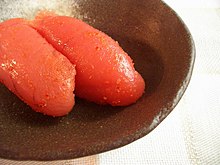
These foods are usually served in tiny portions, as a side dish to be eaten with white rice, to accompanysakeor as a topping for rice porridges.
- Ikura(いくら): salt cured and pickled soy saucesalmonroe.
- Tarako(たらこ):Salt-curedcodroeorpollockroe
- Shiokara(Diêm tân): salty fermentedviscera
- Tsukemono(Tí vật): pickled vegetables, hundreds of varieties and served with most rice-based meals
- Tsukudani(Thuê nấu): Very small fish, shellfish or seaweed stewed in sweetened soy for preservation
- Sunomono(Tạc の vật):vegetables such as cucumber orwakame,or sometimes crab, marinated inrice vinegar
-
Umeboshi(Mai làm)
Side dishes (Tổng đồ ăn)
[edit]
- Bentoor Obento (Biện đương, ngự biện đương) is a combination meal served in a wooden box, usually as a cold lunchbox.
- Chawan mushi(Bát trà chưng し) is meat (seafood and/or chicken) and vegetables steamed in egg custard.
- Edamame(Chi đậu) is boiled and salted pods of soybeans, eaten as a snack, often to accompany beer.
- Himono(Làm vật): dried fish, oftenaji(Japanese jack mackerel,鯵). Traditionally served for breakfast with rice, miso soup and pickles.
- Hiyayakko(Lãnh nô): chilled tofu with garnish
- Nattō(Nạp đậu): fermented soybeans, stringy like melted cheese, infamous for its strong smell and slippery texture. Often eaten for breakfast. Typically popular inKantōandTōhokubut slowly gaining popularity in other regions in which nattō was not as popular
- Ohitashi(お tẩm し):boiled greenssuch as spinach, chilled and flavored with soy sauce, often with garnish
- Osechi(Ngự tiết): traditional foods eaten at New Year
- Japanesesalad dressings
- Wafu dressing(Cùng phong ドレッシング): literally "Japanese-style dressing "is avinaigrette-typesalad dressingbased onsoy sauce,popular inJapan.
- Sanbaizu(Tam ly tạc): The so-called vinegar that is blended with the ingredient here is oftensanbaizu( "three cupful/spoonful vinegar" ),[8]which is a blend ofvinegar,mirin,andsoy sauce.
- Shimotsukare(しもつかれ): made of vegetables, soybeans,abura-age(あぶらあげor deep fried tofu skins) andsake kasu(Rượu phách,rice pulp from fermented sake).
Chinmi (Trân vị)
[edit]
Chinmi(Trân vị)are regionaldelicacies,and include:
- Ankimo(あん gan)
- Karasumi(カラスミ)
- Konowata(こ の わた)
- Mozuku(モズク)
- Uni(ウニ): specifically, salt-pickled sea urchin
Although most Japanese eschew eating insects, in some regions,locust(inago,イナゴ) and bee larvae (hachinoko,Ong の tử) are not uncommon dishes.[citation needed]The larvae of species ofcaddisfliesandstoneflies(zaza-mushi,ざざむし), harvested from theTenryū riveras it flows throughIna, Nagano,is also boiled and canned, or boiled and then sautéed in soy sauce and sugar.[citation needed]Japanese clawed salamander(ハコネサンショウウオ,Hakone Sanshōuo,Onychodactylus japonicus)) is eaten as well inHinoemata, Fukushimain early summer.[citation needed]
Sweets and snacks (okashi(おかし),oyatsu(おやつ))
[edit]- Okashi(おかし),Oyatsu(おやつ): Sweets and snacks
Japanese-style sweets (wagashi,Cùng quả tử)
[edit]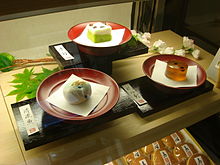
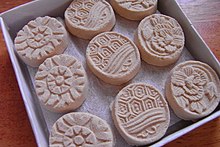
Wagashiinclude:
- Amanattō:traditional confectionery made of adzuki or other beans, covered with refined sugar after simmering with sugar syrup and drying.
- Dango:a Japanese dumpling and sweet made from mochiko (rice flour),[1][citation not found]related to mochi.
- Hanabiramochi:a Japanese sweet (wagashi), usually eaten at the beginning of the year.
- Higashi:a type of wagashi, which is dry and contains very little moisture, and thus keeps relatively longer than other kinds of wagashi.
- Hoshigaki:dried persimmon fruit.
- Imagawayaki:also known asTaikoyaki,is a round Taiyaki and fillings are same.
- Kakigōri:shaved ice with syrup topping.
- Kompeito:crystal sugar candy.
- Manjū:sticky ricesurrounding a sweet bean center.
- Matsunoyuki:a wagashi that resembles a pine tree dusted with snow.
- Mochi:steamed sweet rice pounded into a solid, sticky, and somewhat translucent mass.
- Oshiruko:a warm, sweet red bean (an) soup withmochi:rice cake.
- Uirō:a steamed cake made of rice flour.
- Taiyaki:a fried, fish-shaped cake, usually with a sweet filling such as ared bean paste.
- Namagashi:a type of wagashi, which is a general term for snacks used in the Japanese tea ceremony.
Old-fashioned Japanese-style sweets (dagashi,Đà quả tử)
[edit]Dagashiinclude:
- Karume-yaki:Brown sugar cake that is also called "bakedcaramel".
- Sōsu senbei:ThinSenbei(rice crackers) eaten with brown sauce.
- Mizuame:Sticky liquid sugar candy.
Western-style sweets (yōgashi,Dương quả tử)
[edit]Yōgashiare Western-style sweets, but in Japan are typically very light or spongy.
- Kasutera:"Castella" Iberian-style sponge cake
- Mirukurepu: "mille feuilles": a layered crepe that literally means "one thousand leaves" in French.
Sweets bread (kashi pan,Quả tử パン)
[edit]Kashi paninclude:
- Anpan:bread with sweet bean paste in the center
- Melonpan:a large, round bun which is a combination of regular dough beneath cookie dough. It occasionally contains a melon-flavored cream, though traditionally it is called melon bread because of its general shape resembling that of a melon (not due to any melon flavor).
-
Peanutamanattō
Other snacks
[edit]
Snacksinclude:
- Azuki Ice -vanillaflavoredice creamwith sweet azuki beans
- Koara no māchi
- Umai Bō- puffed corn food with various flavors
- Pocky
- Hello Panda
- Hi-chew
- Ice cream- usual flavors such as vanilla and chocolate are the most common. Distinctly Japanese ones include Matcha Ice (green tea ice cream), less common ones include Goma (black sesame seed) andsweet potatoflavors.
Tea and other drinks
[edit]Tea and non-alcoholic beverages
[edit]
- Amazake
- Genmaichais green tea combined with roasted brown rice.
- Gyokuro:Gyokuro leaves are shaded from direct sunlight for approximately 3 weeks before the spring harvest. Removing direct sunlight in this way enhances the proportions of flavonols, amino acids, sugars, and other substances that provide tea aroma and taste. After harvesting the leaves are rolled and dried naturally. Gyokuro is slightly sweeter than sencha and is famous for its crisp, clean taste. Major growing areas include Uji, Kyōto and Shizuoka prefecture.
- Hōjicha:green tea roasted over charcoal
- Konbu-cha:specifically the tea poured withKombugiving rich flavor inmonosodium glutamate.
- Kukichais a blend of green tea made of stems, stalks, and twigs.
- Kuzuyuis a thick herbal tea made withkudzustarch.
- Matchais powdered green tea. (Green tea ice cream is flavored with matcha, not ocha.)
- Mugichais barley tea, served chilled during summer.
- Sakurayuis an herbal tea made with pickled cherry blossoms.
- Senchais steam treatedgreen tealeaves that are then dried.
- Umecha is a tea drink withumeboshi,which provides a refreshing sourness.
- Kuwacha is a noncaffeinated tea made withwhite mulberryleaves.
Soft drinks
[edit]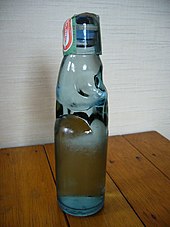
Alcoholic beverages
[edit]Sake(Rượu) is arice winethat typically contains 12–20%alcoholand is made by a doublefermentationof rice.Kōjifungus is first used to ferment the rice starch into sugar. Regular brewing yeast is used in the second fermentation to make alcohol. At traditional meals, it is considered an equivalent to rice and is not simultaneously taken with other rice-based dishes. Side dishes for sake is particularly calledsakana(Hào, rượu và thức ăn), orotsumamiおつまみorateあて.
Shōchūis adistilled beverage,most commonly made from barley, sweet potatoes, or rice. Typically, it contains 25% alcohol by volume.
- Awamori(Phao thịnh)
- Sake(Rượu, Nhật Bản rượu)
- Shōchū(Thiêu trữu)
- Umeshu(Rượu mai)
- Japanese beer(ビール) - leading brands areSapporo,AsahiandKirin
- Japanese whisky-SuntoryandNikka Whisky Distillingare the leading distilleries
-
Barrels ofsake,a traditional Japanese alcoholic drink, on display as an offering at an Itsukushima Shrine
Imported and adapted foods
[edit]Japan has incorporated imported food from across the world (mostly fromAsia,Europeand to a lesser extentthe Americas), and have historically adapted many to make them their own.
Foods imported from Portugal in the 16th century
[edit]- Kasutera— sponge cake, originating in Nagasaki.
- Konpeitō— star shapedsugar candy,the name comes from thePortuguesewordconfeito(comfit).
- Pan— bread, introduced byPortugal.(breadispãoinPortuguese.) Japanese bread crumbs,panko,have been popularized by cooking shows.
- Tempura— so thoroughly adopted that its foreign roots are unknown to most people, including many Japanese. As such, it is consideredwashoku(Cùng thực,native food).
Yōshoku
[edit]Yōshoku(Dương thực) is a style of Western-influenced food.
- Breaded seafood or vegetables (furai,フライ,derived from "fry" ), andbreaded meat(katsuretsu,カツレツ,derived from "cutlet" and often contracted tokatsu), are usually served with shredded cabbage and/or lettuce,Japanese Worcestershireor tonkatsu sauce and lemon. Tempura, a related dish, has been heavily modified since its introduction to Japan by use of batter and dashi-flavored dip, and is usually considered to be washoku.
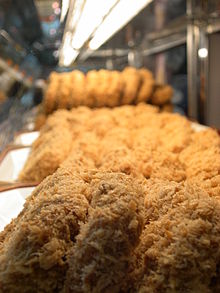
- Kaki furai(カキフライ, con hào フライ) - breaded oyster
- Ebi furai(エビフライ, hải lão フライ) - breaded shrimp
- Korokke( "croquette"コロッケ) - breaded mashed potato and minced meat patties. When white sauce is added, it is called cream korokke. Other ingredients such as crab meat, shrimp, or mushrooms are also used instead of minced meat which are called kani-, ebi-, or kinoko-cream korokke, respectively.
- Tonkatsu,Menchi katsu,chicken katsu, beef katsu, kujira katsu - breaded and deep-fried pork, minced meat patties, chicken, beef, and whale, respectively.
- Japanese curry- rice - imported in the 19th century by way of the United Kingdom and adapted by Japanese Navy chefs. One of the most popular food items in Japan today.[citation needed]Eaten with a spoon. Curry is often eaten with pickled vegetables calledfukujinzukeorrakkyo
- Curry Pan- deep fried bread with Japanese curry sauce inside. ThepirozhkiofRussiawas remodeled, and Curry bread was made.
- Curry udon- is a hot noodle dish where the soup is made of Japanese curry anddashi.May also include meat or vegetables.

- Hayashi rice(ハヤシライス)- beef and onions stewed in a red-wine sauce and served on rice
- Nikujaga- soy sauce-flavored meat and potato stew that has been made in Japan to the extent that it is now considered washoku, but again originates from 19th century Japanese Navy chefs adapting beef stews of the Royal Navy.
- Omu raisu- ketchup-flavored rice wrapped in omelet.
Other items were popularized after the war:
- Hamburg steak- a ground beef patty, usually mixed with breadcrumbs and fried chopped onions, served with a side of white rice and vegetables. Often accompanied withdemiglacesauce. Popular post-war food item served at homes. Sometimes eaten with a fork.



- Spaghetti- Japanese versions include:
- with tomato ketchup, wieners, sliced onion and green pepper (called "naporitan"or" napolitan ")
- withmentaikosauce topped withnoriseaweed (tarako spaghetti,たらこスパゲッティ) (mentaiko spaghetti,Minh Thái Tử スパゲッティ)
- withJapanese curry
- Pizza- The popular American pizza companiesDomino's,Pizza HutandShakey'sall operate in Japan, but Japanese brands such as Aoki's andPizza-Laare higher-grossing and famous for catering to Japanese taste. Many pizza chains offer seasonal toppings. Japanese versions include:
Other homegrown cuisine of foreign origin
[edit]- Japanese Americancuisine
- Burgershave various variations in Japan. Domestic chains likeMOS BurgerandFreshness Burgercater to Japanese tastes with seasonal specials likeTeriyakiBurgersand thekinpirarice burger.
- Korean cuisine
- Kimchifrom Korea is often served withJapanese Chinese cuisine,though the local variant may use thinner cabbage.
- Japanese Chinese cuisine
- Gyoza[9]are a very popular dish in Japan. Gyoza are the Japanese take on theChinese dumplingswith rich garlic flavor. Most often, they are seen in the crispy pan-fried form (potstickers), but they can be served boiled or even deep fried, as well.
- Japanese-only "Chinese dishes" likeebi chili(shrimp in a tangy and slightly spicy sauce)
- Mābō dōfutends to be thinner than Chinese mapo doufu.
- Nikuman,anman, butaman and the obscure negi-man are all varieties ofmantouwith fillings.
- Ramenand related dishes such aschamponandyaki soba
- Yakisoba-panis a sandwich with a filling that resembles chow mein noodles.
- Japanese English cuisine
- Purinis a version ofcaramel custard.
Adaptations
[edit]- California roll- invented in Canada,[10]then first introduced in California.
- Spam musubi- a snack fromHawaiiresemblingonigiri,made withSpam
Seasonings
[edit]Lots of Japanese foods are prepared using one or more of the following:
- Kombu(kelp),katsuobushi(flakes of curedskipjack tuna,sometimes referred to as bonito) andniboshi(dried baby sardines) are often used to makedashistock.
- Negi(Welsh onion),onions,garlic,nira(Chinese chives),rakkyō(Allium chinense) (a type ofscallion).
- Sesame seeds,sesame oil,sesame salt (gomashio),furikake,walnutsorpeanutsto dress.
- Shōyu(soy sauce),dashi,mirin,sugar,rice vinegar,miso,sake.
- Wasabi(and imitation wasabi fromhorseradish),karashi(hot mustard),red pepper,ginger,shiso(perilla or beefsteak plant) leaves,sansho,citruspeel, andhoneywort(calledmitsuba).
- A citrus fruit calledyuzuis also a frequent condiment, mashed up into a relish, sold asyuzukoshōand is blended with pepper/chili and salt.Yuzukoshōis eaten with many dishes, adding a flavorful kick to broth/soup items such asoden,nikujaga,tonjiru,udonas well as other dishes.Yuzuis also seen to flavor teas, jams or zeri (jelly), and any number of sweets from yuzu-an (a type ofbean paste) to yuzu-hachimitsu (yuzu-honey).
Less traditional, but widely used ingredients include:
- Monosodium glutamate,which is often used by chefs and food companies as a cheap flavor enhancer. It may be used as a substitute for kombu, which is a traditional source of freeglutamate
- Japanese-style Worcestershire sauce,often known as simply "sauce", thicker and fruitier than the original, is commonly used as a table condiment forokonomiyaki(お hảo み thiêu き),tonkatsu(トンカツ),croquette( "korokke",コロッケ) and the like.
- Japanese mayonnaiseis used with salads,okonomiyaki(お hảo み thiêu き),yaki soba(Thiêu きそば) and sometimes mixed with wasabi or soy sauce.
See also
[edit]- List of Japanese cooking utensils
- List of Japanese ingredients
- List of Japanese condiments
- List of Japanese desserts and sweets
- List of Japanese soups and stews
References
[edit]- ^Cwiertka, K.J. (2006).Modern Japanese Cuisine: Food, Power and National Identity.University of Chicago Press. p. 229.ISBN978-1-86189-298-0.RetrievedJune 16,2017.
- ^Tsuji, Shizuo; M.F.K. Fisher (2007).Japanese Cooking: A Simple Art(25 ed.). Kodansha International. pp. 280–281.ISBN978-4-7700-3049-8.
- ^Inada, S. (2011).Simply Onigiri: fun and creative recipes for Japanese rice balls.Marshall Cavendish International (Asia) Private Limited. p. 86.ISBN978-981-4484-95-4.RetrievedJune 16,2017.
- ^"Maki-zushi (Sushi rolls)".NHK.2011-11-25.Archivedfrom the original on 2017-11-20.Retrieved2022-06-01.
- ^Stanlaw, James (2004).Japanese English: language and culture contact.Hong Kong University Press. p. 46.ISBN962-209-572-0.
- ^Sen, Colleen Taylor (2009).Curry: a Global History.London: Reaktion Books. p. 116.ISBN9781861895226.
- ^ほたて の レシピ[Recipes for scallops].Thanh sâm huyện ngư nghiệp hợp tác tổ hợp liền hợp sẽ (Aomori fishers' cooperations' association)(in Japanese). もと thiêu き (motoyaki).Archivedfrom the original on 2021-07-20.Retrieved2021-07-20.
(rough translation) Ingredients oftamagonomoto:2 egg yolks; 1 tbsp miso; 1 tbsp sugar; salt; pepper
- ^Shimbo, Hiroko (2000),The Japanese Kitchen: 250 Recipes in a Traditional Spirit,Harvard Common Press,ISBN978-1-55832-177-9p.147 "wakame and cucumber in sanbaizu dressing (sunomono)"; p.74 "sanbaizu" recipe
- ^"Gyoza (Japanese dumplings)".BBC.Retrieved14 October2013.
- ^McInerney, Jay (June 10, 2007)."Raw".The New York Times.Retrieved14 October2013.

